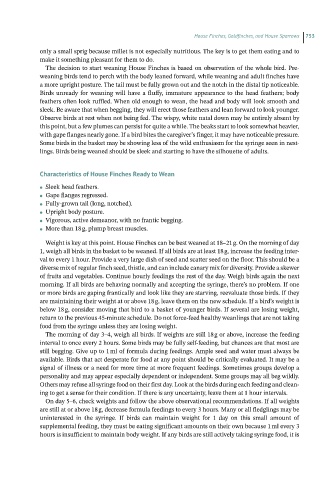Page 751 - Hand rearing birds second
P. 751
House Finches, Goldfinches, and House Sparrows 753
only a small sprig because millet is not especially nutritious. The key is to get them eating and to
make it something pleasant for them to do.
The decision to start weaning House Finches is based on observation of the whole bird. Pre‐
weaning birds tend to perch with the body leaned forward, while weaning and adult finches have
a more upright posture. The tail must be fully grown out and the notch in the distal tip noticeable.
Birds unready for weaning will have a fluffy, immature appearance to the head feathers; body
feathers often look ruffled. When old enough to wean, the head and body will look smooth and
sleek. Be aware that when begging, they will erect those feathers and lean forward to look younger.
Observe birds at rest when not being fed. The wispy, white natal down may be entirely absent by
this point, but a few plumes can persist for quite a while. The beaks start to look somewhat heavier,
with gape flanges nearly gone. If a bird bites the caregiver’s finger, it may have noticeable pressure.
Some birds in the basket may be showing less of the wild enthusiasm for the syringe seen in nest-
lings. Birds being weaned should be sleek and starting to have the silhouette of adults.
Characteristics of House Finches Ready to Wean
Sleek head feathers.
●
Gape flanges regressed.
●
Fully‐grown tail (long, notched).
●
Upright body posture.
●
Vigorous, active demeanor, with no frantic begging.
●
More than 18 g, plump breast muscles.
●
Weight is key at this point. House Finches can be best weaned at 18–21 g. On the morning of day
1, weigh all birds in the basket to be weaned. If all birds are at least 18 g, increase the feeding inter-
val to every 1 hour. Provide a very large dish of seed and scatter seed on the floor. This should be a
diverse mix of regular finch seed, thistle, and can include canary mix for diversity. Provide a skewer
of fruits and vegetables. Continue hourly feedings the rest of the day. Weigh birds again the next
morning. If all birds are behaving normally and accepting the syringe, there’s no problem. If one
or more birds are gaping frantically and look like they are starving, reevaluate those birds. If they
are maintaining their weight at or above 18 g, leave them on the new schedule. If a bird’s weight is
below 18 g, consider moving that bird to a basket of younger birds. If several are losing weight,
return to the previous 45‐minute schedule. Do not force‐feed healthy weanlings that are not taking
food from the syringe unless they are losing weight.
The morning of day 3–4, weigh all birds. If weights are still 18 g or above, increase the feeding
interval to once every 2 hours. Some birds may be fully self‐feeding, but chances are that most are
still begging. Give up to 1 ml of formula during feedings. Ample seed and water must always be
available. Birds that act desperate for food at any point should be critically evaluated. It may be a
signal of illness or a need for more time at more frequent feedings. Sometimes groups develop a
personality and may appear especially dependent or independent. Some groups may all beg wildly.
Others may refuse all syringe food on their first day. Look at the birds during each feeding and clean-
ing to get a sense for their condition. If there is any uncertainty, leave them at 1 hour intervals.
On day 5–6, check weights and follow the above observational recommendations. If all weights
are still at or above 18 g, decrease formula feedings to every 3 hours. Many or all fledglings may be
uninterested in the syringe. If birds can maintain weight for 1 day on this small amount of
supplemental feeding, they must be eating significant amounts on their own because 1 ml every 3
hours is insufficient to maintain body weight. If any birds are still actively taking syringe food, it is

